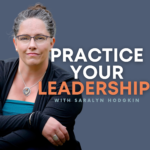Hey everyone, I’m Saralyn Hodgkin. And this is the podcast to practice your leadership.
Resiliency was key for us to hold on to, to treasure, hey, we’ve talked about compassion, fatigue, and burnout and stress and so on this week, and lots of us are having kids go back to school and you know, that the conversation can get really weighty. And so I’m offering the conversation from a lens of resiliency, and gratitude and possibility. What if we stand in a place of smiling with our feet in the grass and saying, Wow, I am trying to build towards resiliency, versus a narrative of tired, you know.
And so, I thought, coming into a conversation of talking about resiliency, we can talk about the theory of that, and so on. But my interest just for this moment, and for this episode, is to talk about resiliency as a practice, as a way of getting you back into a maybe it’s back on track or entering into or continuing a headspace of resiliency, of having a clear head, of being able to have the the practice and the potential within you to create that responsiveness rather than reactivity, right?
That emotional responsiveness in places of being triggered, of being able to, to create and hold open your window of tolerance, of being able to have a wide open window of being able to tolerate and find resiliency in those things that that trigger us. People like David Treleavan, and others talk about window of tolerance and a lot of other places I, I definitely didn’t come up with this term. But man it’s another good one, right? Keeping, keeping that window of responsiveness and tolerance open. And part of that is listening to your own warning signs and having your own list of signals to be aware of when you’re getting triggered and your your tolerance window is shrinking. And of course, and that list isn’t just to have a list, but is to be able to have a list activate Wow, I really need to be putting a little bit more of my emotional currency, my energetic currency into building and holding my practice of resilience.
And so what are those tools? What is your resiliency toolkit for your practice? And what does it do for you? Does it help you make your day happier? Does it help you surf the waves of destabilization and change and conflict? And does it help you just be able to get clear on those warning signals? What is the purpose of your resiliency toolkit? What are the effects on your leadership, on your practice, on yourself? When you contribute your currency to resiliency? And what is your practice? What are those tools?
Let me offer some. Maybe your resiliency toolkit, which I totally suggest that you start creating, maybe it includes the emotion wheel, I’ll get into that resources section the emotion wheel, the one that I use is by a colleague of mine, I really respect Abby Vanmuijen. I have that on my tablet and I click into that file and open it up and use my tablet pen. Just as a quick how am I, where am I at? Why can I not focus right now on any one thing? Okay, emotion. Well, where are my emotions at? Well, I’ve just started a podcast, where are my emotions at? Right? Circle Circle Circle. Helps me just get really literate in where are my emotions and what are they telling me? So it’s a nice tool to have in my toolbox. Great.
Another one, breathing. I know it sounds so easy, doesn’t it? And yet, I think it’s one of my most powerful tools. So maybe you have an app, peloton, headspace, whatever, mindfulness app or insight timer, any of these resources that are out there that help you connect to your breath, but what does it look like to stand for a moment? 60 seconds before that meeting, at the end of the day before you step out of your desk and into the kitchen and your family, right? What does it look like to pause? Inhale, exhale.
Put your attention on the leaf that’s on the tree outside, on the picture that is at your gaze, just something that makes you feel present. What does it look like to rub your finger and your thumb together so slowly as you breathe, that you can feel the ridges of your skin to become present and to use that breath. That’s part of my toolbox. Another one is power posing, google that one. There’s some great things around power posing, but stand up, two feet planted, chest out, shoulders broad. Power pose. Power posing really helps me.
Also, being able to come and be still and pause and quiet. You may have a practice around connecting to nature, feet in the grass, rocks in your pocket, hands on the tree bark, whatever that looks like for you. Maybe you’re creating a practice where you’re walking through trees three times a week, whatever that looks like for you. Adding nature into your toolbox.
And then of course, diving into that toolbox, gratitude. I think it’s Brene Brown, who talks about how gratitude practice is required to get into that joy, that place of joy. And what does that gratitude practice look like for you, a lot of people have a practice where in the morning, you write down, you may journal about your day in the incoming day. But then at the end of the night, you write down three things that you’ve been grateful for today. Simple, or maybe you do it in the morning, three things I’m grateful for over the course of my life. Anything that brings gratitude into the forefront is helpful. Doing it with your kids, doing it when you’re driving in the car.
Lastly, presencing. Having a practice of actual presencing. I use a four step process where I catch my triggers. I try to catch myself in a trigger, just catching and acknowledging is helpful catching it, naming that trigger of what’s happening right now and then renarrating it into something where my inner critic isn’t leading the narrative, and then nurturing myself so I can be more responsive. I have a practice around that, of just trying to find my presence so I can be responsive. Keep that window of tolerance open and feel the effects of that practice and how I show up.
Resiliency. Having a resilient state, being able to continually craft and dig into your resiliency toolkit. It’s a practice. Stay in the practice all.
Thanks. I’m Saralyn. You can find me at holonleadership.org. I walk alongside you as you practice your leadership.


 Apple Podcasts
Apple Podcasts Spotify
Spotify Google Podcasts
Google Podcasts